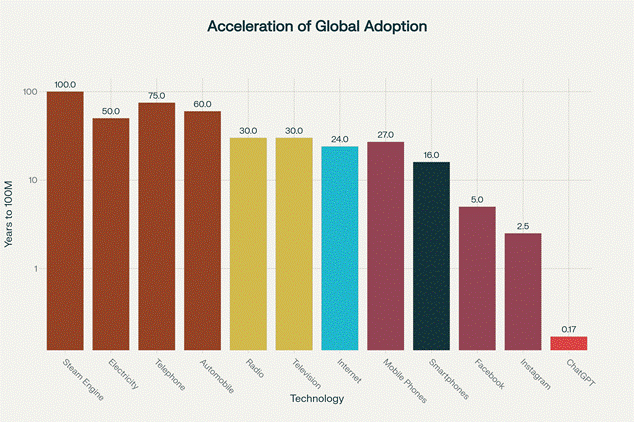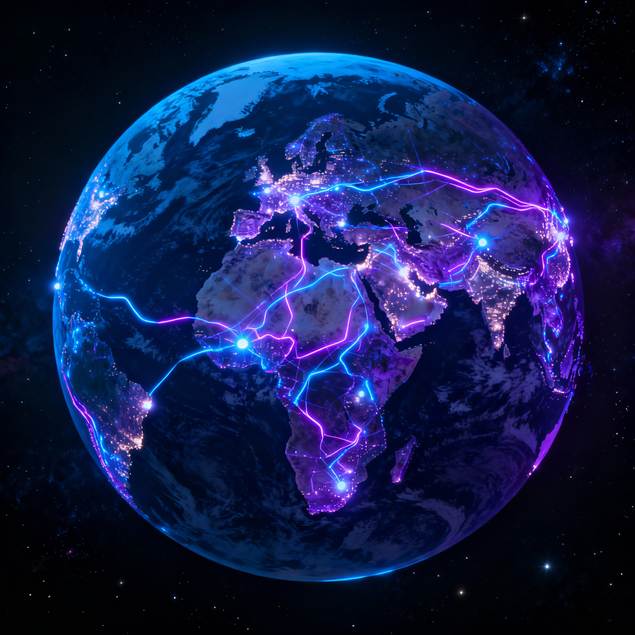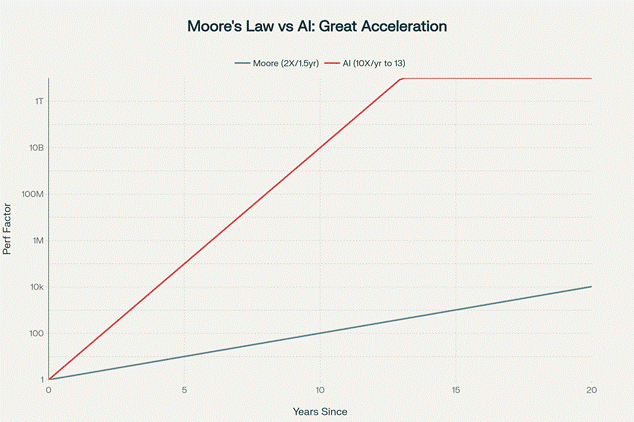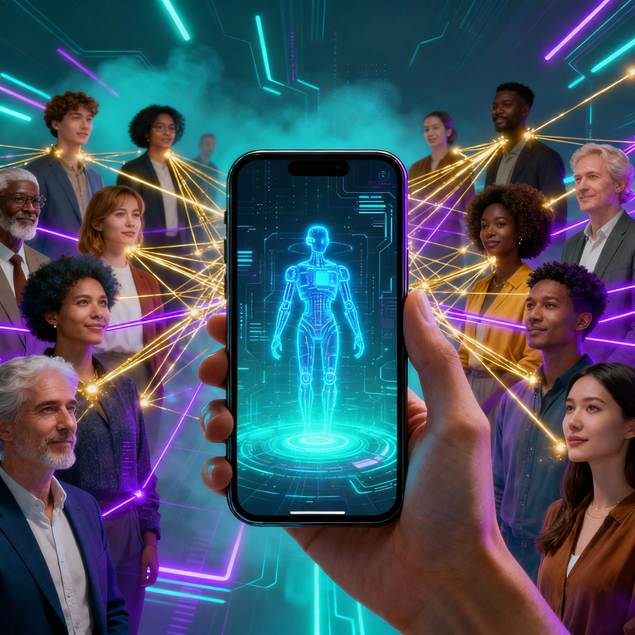A Technological Revolution Measured in Days, Not Decades
For over two centuries, humanity has witnessed the transformative power of General Purpose Technologies—innovations so fundamental they reshape entire economies and societies. The steam engine powered the Industrial Revolution over a century-long diffusion. Electricity took half a century to illuminate the world. The telephone required 75 years to connect 100 million people.[1][2][3][4]
Then came ChatGPT.
On November 30, 2022, OpenAI released a conversational AI that would shatter every historical precedent for technology adoption. Within 60 days, ChatGPT reached 100 million monthly active users—a milestone that took electricity 50 years, the internet 24 years, and even Instagram 2.5 years to achieve. By October 2025, ChatGPT serves 700-800 million weekly active users, processing 2.5 billion prompts daily.[5][6][7][8][9]
This unprecedented velocity represents more than just impressive growth metrics. It signals a fundamental shift in how transformative technologies diffuse through society—and with it, a complete reimagining of innovation, competition, and economic opportunity in the 21st century.
Understanding General Purpose Technologies: From Steam to Silicon to Synapses
The Archetypal Pattern: Slow, Restricted, Sequential
General Purpose Technologies (GPTs) are foundational innovations characterized by three essential properties: pervasive applicability across sectors, continuous improvement over time, and the ability to spawn complementary innovations. Historical GPTs include the steam engine, electricity, internal combustion engine, and information technology.[1][2][3][10][11][12]
The steam engine exemplifies the traditional GPT diffusion pattern. Thomas Newcomen developed the first commercially viable steam engine around 1712, yet it took until James Watt's improvements in the 1760s-1770s for the technology to become economically practical beyond mine drainage. Even then, adoption crawled forward. By 1800, only a few thousand steam engines operated worldwide. Widespread industrial adoption didn't occur until the mid-19th century—nearly 150 years after Newcomen's invention.[2][4][1]
Why so slow? Infrastructure requirements created insurmountable barriers. Steam engines needed coal distribution networks, skilled engineers to operate them, factories redesigned around central power sources, and regulatory frameworks for industrial safety. Each barrier took decades to overcome.[4][1][2]
Electricity followed a similar trajectory. Thomas Edison's Pearl Street Station began commercial electricity distribution in New York in 1882, yet by 1919—nearly 40 years later—only 30% of U.S. factories used electric motors. Full electrification of American homes took until the 1950s, 70 years after Edison's breakthrough. Again, infrastructure dictated pace: power plants, transmission lines, standardized voltages, and complete factory reorganization all required massive capital investment and decades of construction.[3][11][12]
The telephone, invented by Alexander Graham Bell in 1876, required approximately 75 years to reach 100 million users. The "last-mile problem"—physically connecting copper wire to every home and business—limited how quickly adoption could proceed regardless of consumer demand.[13][14][15]

From steam engines taking a century to ChatGPT reaching 100 million users in 60 days—technology adoption has accelerated 600X
The Digital Acceleration: Internet and Smartphones
The late 20th century saw adoption timelines compress. The internet, operational by 1970 with ARPANET, achieved 100 million users by approximately 1994—a 24-year journey. While dramatically faster than electricity or telephones, this still represented a generation-long diffusion requiring:[13][14][15]
- University and government investment in computer science
- Development of TCP/IP protocols and user-friendly browsers
- Deployment of fiber optic networks and modems
- Training in computer literacy and internet navigation[14][15][13]
Smartphones accelerated further. While early devices like IBM's Simon (1994) and Palm PDAs attracted limited audiences, Apple's iPhone launch in 2007 catalyzed mass adoption. Smartphones reached 100 million users in approximately 16 years from the first devices. The key enabler: mobile networks already existed, dramatically reducing infrastructure barriers compared to electricity or telephones.[15][13]
Social media then shattered previous records. Facebook took about 5 years to reach 100 million users (2004-2009). Instagram achieved it in 2.5 years (2010-2012). These platforms benefited from existing internet infrastructure, smartphone penetration, and network effects where each new user increased value for existing users.[6][7][13][15]
Yet even Instagram's impressive 2.5-year adoption paled compared to what was coming.
ChatGPT: The Inflection Point in Technology Diffusion
60 Days to 100 Million: Anatomy of Unprecedented Adoption
On December 5, 2022—just five days after launch—ChatGPT reached 1 million users. This alone set a record, surpassing Instagram's mobile app downloads (2.5 months) and Spotify (5 months). But ChatGPT's momentum only accelerated.[5][6][7]
By January 2023, ChatGPT had achieved an estimated 100 million monthly active users—exactly two months after launch. UBS analysts remarked: "In the 20 years we have been tracking the internet space, we cannot recall a faster ramp in a consumer internet application".[6][7][8][16][5]
The growth trajectory continued its exponential climb:
- January 2023: 100 million monthly users[7][8][6]
- November 2023: 100 million weekly users (12 months post-launch)[8]
- February 2025: 400 million weekly users[5][6]
- October 2025: 700-800 million weekly users[9][6][5]
ChatGPT now ranks as the 5th most-visited website globally, with approximately 4.61 billion monthly visits. Users send 2.5 billion prompts daily. OpenAI projects reaching 1 billion users by the end of 2025.[6][9][5]
The Three Unprecedented Characteristics of AI Diffusion
ChatGPT's explosive adoption stems from three revolutionary characteristics that differentiate AI from every previous GPT:
1. Zero Infrastructure Barriers: Instant Global Accessibility
Unlike every previous GPT, AI required zero new physical infrastructure. There were no power plants to build, no telephone lines to install, no fiber optic cables to bury. ChatGPT launched as a website and mobile app accessible to anyone with an internet connection.[6][17][18]
In November 2022, 5.65 billion people worldwide already had internet access via existing networks. This meant ChatGPT could theoretically reach 70% of humanity from day one—no waiting decades for infrastructure rollout.[15]
Mobile accessibility proved transformative. By 2022, smartphones had achieved 96% penetration in the United States and widespread adoption globally. ChatGPT's mobile app launched simultaneously with its web interface, enabling access anywhere, anytime. A farmer in rural India, a student in Brazil, and an entrepreneur in Kenya could all access the same cutting-edge AI technology immediately—for free.[5][13][19][17][18][6]
This "zero infrastructure barrier" represents a complete departure from historical GPT patterns. Where electricity required 70 years and trillions in infrastructure investment to electrify America, AI achieved global accessibility overnight by riding existing digital infrastructure.[11][12][15]

AI's unprecedented global diffusion through instant digital accessibility
2. Universal Capability: Mechanizing All Cognitive Skills
Previous GPTs mechanized specific functions. Steam engines provided rotational power. Electricity delivered energy. Telephones transmitted voice. Even computers in the IT era primarily enhanced two capabilities: numerical computation and information storage/retrieval.[1][2][20][21]
AI mechanizes virtually every cognitive skill humans possess—and some we don't:[20][21][22][23][24]
- Creative writing: AI generates articles, stories, poetry, and marketing copy indistinguishable from human-written content
- Visual art: AI creates images, designs, videos, and illustrations across any style or medium
- Programming: AI writes code, debugs errors, explains algorithms, and architects software systems
- Analysis and reasoning: AI performs legal research, medical diagnosis, financial analysis, and strategic planning
- Communication: AI translates languages, adapts cultural context, and personalizes messaging
- Education: AI tutors students, adapts curriculum, grades assignments, and answers questions
- Customer service: AI handles inquiries, resolves complaints, and builds relationships at scale[22][23][24][25][26]
This comprehensiveness means AI impacts every industry simultaneously rather than diffusing sector by sector as previous GPTs did. A single AI model like GPT-4 or Claude can assist a lawyer drafting contracts, help a marketer create campaigns, teach a student calculus, write software for an engineer, and generate artwork for a designer—all with the same underlying technology.[11][12][23][24][27][22]
The scope of mechanization is unprecedented. The IT era automated number-crunching and memory. AI automates reasoning, creativity, judgment, and even emotional intelligence. This leaves virtually no cognitive domain untouched.[21][20]
3. Super-Exponential Growth: Beyond Moore's Law
Perhaps the most striking difference between AI and previous GPTs lies in the pace of capability improvement.

AI compute power has grown 10,000X faster than Moore's Law predicted, creating a super-exponential trajectory
Moore's Law, formulated by Intel co-founder Gordon Moore in 1965, observed that the number of transistors on integrated circuits doubled approximately every two years (often cited as 18 months when combined with performance improvements from Dennard scaling). This 2X growth every 18 months created predictable, exponential progress that powered five decades of computing advancement.[28][29][30][31][32]
AI compute power has doubled every 3.4 months since 2012. This translates to approximately 10X annual growth—five to seven times faster than Moore's Law.[20][21][33][34]
The implications are staggering:
- 10-year improvement: Moore's Law ~100X; AI compute ~100,000X (1,000X faster)[21][20]
- 20-year improvement: Moore's Law ~10,000X; AI compute ~10 billion X (1 million times faster)[20][21]
Nvidia CEO Jensen Huang describes this as "Moore's Law squared" or "hyper Moore's Law". In the decade from 2012 to 2022, AI progressed as much as Moore's Law would predict for 100 years.[33][34][21][20]
This super-exponential trajectory creates fundamentally different competitive dynamics. Where a company could maintain technological advantage for 3-5 years in the PC era, AI advantages can be replicated in months or even weeks. The "moat" duration has compressed from decades to seasons.[35][21][20]
Why AI Achieved Instant Mass Adoption: Breaking Down the Barriers
The Democratization Trinity: Access, Affordability, Usability
Three factors combined to create AI's unprecedented diffusion velocity:
1. Universal Access Through Mobile Apps
ChatGPT launched on November 30, 2022, as both a website and mobile app, free to use, with no waiting list or approval process. Anyone, anywhere, with a $50 smartphone and basic internet connection could access frontier AI technology instantly.[5][6][17][18]
This contrasts dramatically with previous GPTs:
- Electricity: Required proximity to power grid (decades of infrastructure)
- Telephone: Needed physical line installation ($100s-$1000s per household)
- Internet: Required computer ($1000+), modem, ISP subscription, technical knowledge
- AI: Required smartphone (already owned by billions) and app download (free)[13][15][17][18]
The mobile-first strategy proved decisive. By October 2025, mobile devices account for the majority of ChatGPT's 4.61 billion monthly visits. The technology reached users wherever they were—commuting, at home, in rural villages—without requiring them to visit computer labs or offices.[6][17][18][5]
2. Zero Marginal Cost Economics
OpenAI initially offered ChatGPT completely free, removing all economic barriers to adoption. While compute costs for OpenAI were substantial ($700,000+ daily by some estimates), marginal cost per user remained negligible—fractions of a cent per interaction.[7][18][25][36][5][6]
This enabled a business model impossible in previous GPT eras:
- Free tier attracts hundreds of millions who experience AI's capabilities
- Premium tier ($20/month) converts power users who need faster response and advanced features
- Enterprise tier serves businesses requiring security and customization[25][5][6]
By February 2025, ChatGPT had attracted 15.5 million paid subscribers and 1.5 million enterprise customers—generating $3.7 billion in 2024 revenue. The free tier served as a massive funnel, converting 2-3% to paid while maintaining accessibility for billions.[5]
3. Natural Language Interface: The Ultimate Usability
Perhaps most revolutionary: ChatGPT required zero technical training. Users simply typed questions in natural language and received coherent answers.[17][18][6][5]
Compare this to previous technologies:
- Computers: Required learning operating systems, file management, application software
- Internet: Needed understanding of browsers, URLs, search queries, email protocols
- Smartphones: Demanded touchscreen proficiency, app navigation, settings management
- AI: Required only the ability to ask questions in plain language[15][18][13][17]
The conversational interface eliminated the "adoption friction" that slowed previous technologies. A grandmother could use ChatGPT as easily as a software engineer. No manuals, no training courses, no certifications—just conversation.[18][17][5]
This accessibility meant adoption didn't wait for generational turnover as it had with computers and the internet. Both young and old could adopt immediately, compressing the adoption curve from decades to months.[37][38][13][15]
Network Effects and Viral Growth
Unlike previous GPTs, AI adoption created immediate viral growth mechanisms:
Social proof through sharing: Users shared impressive ChatGPT outputs on Twitter, LinkedIn, and other platforms, creating millions of "AI moment" posts that drove curiosity. Each viral post converted thousands of new users who wanted to experience the magic themselves.[5][6][9]
Use case discovery: As millions experimented, they discovered novel applications—writing resumes, debugging code, creating meal plans, explaining complex topics, translating languages—that drove further adoption. Each use case attracted new user segments.[6][9][5]
Competitive pressure: Businesses saw competitors adopting AI and felt compelled to explore it themselves, creating "fear of missing out" adoption dynamics. By early 2024, 92% of Fortune 100 companies used ChatGPT.[8][25][35][39][5]
Developer ecosystem: OpenAI released APIs enabling developers to build applications powered by GPT models, creating thousands of AI-enhanced products that introduced millions more users to AI capabilities.[23][24][8]
This virtuous cycle—viral sharing driving adoption, driving use case discovery, driving more adoption—sustained exponential growth for over two years.[9][5][6]

AI democratization through mobile access empowers billions globally
The Transformed Technology Adoption Curve
From Decades to Days: Collapsing the Traditional Timeline
The classic technology adoption curve, theorized by Everett Rogers in 1962, segments populations into five groups:
- Innovators (2.5%): Technology enthusiasts who adopt first
- Early Adopters (13.5%): Visionaries who see strategic potential
- Early Majority (34%): Pragmatists who need proof of value
- Late Majority (34%): Skeptics who adopt when technology becomes norm
- Laggards (16%): Traditionalists who resist change[13][40][41][37][38]
Historically, moving through these segments took decades:
- Electricity: Innovators (1880s-1900), Early Adopters (1900-1920), Early Majority (1920-1940), Late Majority (1940-1960), Laggards (1960-1980)[19][11][12]
- Telephones: Similar 50-75 year progression[14][15]
- Internet: Innovators (1970s), Early Adopters (1980s-early 1990s), Early Majority (mid-1990s-2000), Late Majority (2000-2010), Laggards (2010-present)[15][13][14]
AI compressed this timeline from decades to months:
- Innovators (Days 1-7): Tech enthusiasts and AI researchers
- Early Adopters (Weeks 1-4): Developers, entrepreneurs, digital natives
- Early Majority (Months 2-6): Professionals, students, businesses
- Late Majority (Months 6-18): General consumers, mainstream organizations
- Laggards (Years 2-5): Digital skeptics, privacy-concerned, resistant adopters[5][6][13][15]
ChatGPT reached the Early Majority within 6 months—a journey that took electricity 60 years and the internet 30 years.[6][7][8][12][5][15]
The Declining Importance of Demographics
Traditional adoption curves showed strong demographic patterns. Younger, wealthier, better-educated, and urban populations adopted first. Older, poorer, less-educated, and rural populations lagged by decades.[13][14][37][15]
AI's zero-infrastructure, zero-cost, natural-language characteristics weakened these patterns dramatically:
Age barriers reduced: While millennials and Gen Z still adopt fastest (45% of users under 25), ChatGPT sees significant adoption across all age groups including those over 50. The conversational interface eliminates much of the "digital divide" that plagued internet and smartphone adoption.[5][17][18][13]
Geographic barriers eliminated: A developer in Lagos has access to the same AI models as one in Silicon Valley. Rural users can leverage AI as effectively as urban ones, provided basic internet connectivity exists. The 19% U.S. user share, 7% India, 5% Brazil distribution shows global reach rather than first-world concentration.[15][42][43][5]
Income barriers reduced: Free access means low-income users can adopt immediately. While paid tiers exist, the free version provides sufficient capability for most use cases, ensuring economic status doesn't determine AI access.[6][42][43][5]
Education barriers minimized: The natural language interface means users don't need computer science degrees or technical training. A high school student can leverage AI as effectively as a PhD.[17][18][5]
This democratization represents a profound shift. For the first time in GPT history, a transformative technology reached global mass adoption without waiting for the privileged few to adopt first, then slowly diffusing to everyone else.[42][43][15][17]
Global Innovation Models Transformed
The End of Sequential Innovation Diffusion
Historically, GPTs diffused sequentially—first to wealthy nations, then gradually to developing economies.
Electricity reached American and European cities in the 1880s-1900s but didn't arrive in many developing nations until the 1950s-1980s—a 70-year lag. This created decades of competitive advantage for early-adopting nations.[19][44][11][12]
Internet followed similar patterns. By 2000, over 50% of Americans had internet access, compared to less than 5% in most African and South Asian nations. This "digital divide" persisted for decades.[14][15]
AI's instant global accessibility eliminates sequential diffusion. A startup in Bangalore can leverage the same GPT-4 or Claude models as one in San Francisco, from day one. There's no waiting decades for AI infrastructure to reach developing nations—it's already there via cloud APIs.[22][26][42][43]
This simultaneous global adoption creates unprecedented competitive dynamics:
Geographic advantages evaporate: Silicon Valley's concentration of AI talent and capital still matters, but no longer guarantees multi-decade leads. A brilliant AI application can emerge anywhere.[35][42][43]
Innovation cycles accelerate globally: Rather than innovations diffusing from developed to developing economies over decades, all regions innovate simultaneously. DeepSeek (China) disrupting OpenAI (U.S.) and Mistral (France) competing with both exemplifies this new reality.[26][45][46][47][48]
Talent access globalizes: Remote work and AI collaboration tools mean companies can hire the best talent worldwide, rather than being constrained by geography.[42][43][49]
The Democratization of Capability
Previous GPTs created capability gaps between those with access and those without, lasting decades.
AI creates capability gaps measured in weeks. When GPT-4 launched (March 2023), everyone globally gained access to frontier AI simultaneously. When Claude 3 launched (March 2024), it was instantly available worldwide. When ChatGPT added Advanced Voice Mode (September 2024), users in 150+ countries received it concurrently.[5][6][23][26]
This synchronous capability distribution means:
No "waiting for technology to arrive": Developing nations don't wait decades for AI while developed nations reap benefits. Both adopt and benefit simultaneously.[42][43]
No "technological colonialism": Previous GPT eras saw developed nations maintain dominance by controlling access to transformative technologies. Open-source AI models (LLaMA, Mistral, DeepSeek) prevent any single nation or company from monopolizing AI capability.[22][26][45][46][47][48]
Rapid leapfrogging: Regions that skipped PC and even desktop internet eras can jump directly to AI-first computing via smartphones. Mobile-first AI deployment in Africa and Southeast Asia already shows this pattern.[15][5][42]
The Innovation Acceleration Paradox
Here lies AI's most profound implication for global innovation: Barriers to entry collapse while competitive intensity explodes.
Traditional GPT eras saw:
- High barriers (capital, infrastructure, expertise) limiting competitors
- Slow diffusion allowing early movers decades of advantage
- Predictable competitive landscapes with clear leaders[11][12][35]
AI era dynamics:
- Near-zero barriers enabling thousands of competitors
- Instant diffusion giving early movers months, not decades, of advantage
- Hyper-competitive landscapes where advantages erode rapidly[25][35][42][43]
A startup can now:
- Launch an AI product in days with minimal capital
- Reach global markets immediately
- Iterate and improve 10-100X faster than traditional product cycles
- But also face 100X more competition from equally capable global rivals[42][43][49]
This creates what we might call "democratized creative destruction"—where both opportunity and disruption accelerate simultaneously, available to everyone, everywhere.[35][43][42]
Conclusion: The Implications of Instant Global Adoption
AI's unprecedented diffusion velocity—100 million users in 60 days versus 50 years for electricity—represents far more than an impressive growth statistic. It signals a fundamental transformation in how humanity adopts and is transformed by General Purpose Technologies.[5][6][7][11][12]
For the first time in human history, a civilization-scale transformative technology achieved global mass adoption instantly, without waiting for infrastructure, without restricting access by wealth or geography, and without requiring specialized training. The implications cascade across every dimension of society:[6][15][17][42][43][5]
Economic: Geographic competitive advantages that persisted for decades in previous GPT eras now last months. Innovation cycles accelerate from years to weeks. Capital requirements for startups drop 90-99%, enabling 1000X more entrepreneurs to compete globally.[25][35][42][43]
Social: The "digital divide" that separated developed and developing nations for decades compresses dramatically. A billion people who couldn't afford computers can now access frontier AI via smartphones they already own.[15][17][42][5]
Educational: Knowledge access democratizes completely. Every student globally can now access an AI tutor as capable as the best human teachers. Learning gaps that took generations to close can now narrow in years.[43][49][5]
Geopolitical: Technological dominance no longer guarantees multi-decade leads. Open-source AI (LLaMA, Mistral, DeepSeek) prevents any single nation from monopolizing AI capability. Power diffuses globally.[22][26][35][45][46][47][48]
Innovation: The pace of change itself accelerates. Where Moore's Law created predictable 2X every 18 months progress, AI's 10X annual improvement creates a "permanent revolution" where yesterday's breakthroughs become today's commodities.[20][21][33][34][35]
Yet challenges intensify proportionally: Competitive moats erode 5-10X faster. Winner-takes-all dynamics threaten despite democratized access. Ethical concerns around AI bias, misinformation, and privacy scale with adoption. Regulatory frameworks struggle to keep pace with technology advancing monthly rather than yearly.[35][36][50][51][52][43]
The fundamental question becomes: In an era when transformative technology reaches billions in weeks rather than decades, how do societies, economies, and individuals adapt fast enough to capture benefits while mitigating risks?
The answer will define the 21st century. For the first time, we're running an unprecedented global experiment: what happens when everyone, everywhere, gains access to transformative capability simultaneously?
History suggests GPTs require decades to diffuse precisely because societies need time to adapt—to build complementary infrastructure, develop new skills, create regulatory frameworks, and reimagine social structures.[14][41][11][12]
AI collapsed the diffusion timeline from decades to months. The adaptation timeline, however, cannot be similarly compressed. Therein lies both the extraordinary opportunity and the profound challenge of the AI era.
The fastest adoption in human history has arrived. The race now is whether human adaptation can keep pace with technological transformation—or whether we'll experience the growing pains of a civilization moving at AI speed while thinking at human speed.
Written leveraging AI Tools through Perplexity Pro Modules
Sources:[1][13][2][3][7][4][8][41][37][9][28][29][30][31][11][12][17][18][21][36][42][49][50][51][5][6][14][15][20][35][43]
⁂
- https://en.wikipedia.org/wiki/Steam_engine
- https://www.lse.ac.uk/Economic-History/Assets/Documents/Research/LSTC/wp7503.pdf
- https://en.wikipedia.org/wiki/General-purpose_technology
- https://www.britannica.com/technology/steam-engine
- https://nerdynav.com/chatgpt-statistics/
- https://explodingtopics.com/blog/chatgpt-users
- https://www.reuters.com/technology/chatgpt-sets-record-fastest-growing-user-base-analyst-note-2023-02-01/
- https://techcrunch.com/2023/11/06/openais-chatgpt-now-has-100-million-weekly-active-users/
- https://pub.towardsai.net/inside-chatgpt-how-700-million-people-actually-use-ai-0b9ce2e1bec6
- https://www.linkedin.com/pulse/general-purpose-technology-gpts-simplified-rajarshi-gupta
- https://jeffreyjding.github.io/documents/Rise and Fall of Technological Leadership ISQ Accepted Manuscript March 2024.pdf
- https://academic.oup.com/ereh/article/18/3/227/2754563
- https://whatfix.com/blog/technology-adoption-curve/
- https://www.ineteconomics.org/uploads/papers/TechnologyDiffusion.pdf
- https://www.visualcapitalist.com/charted-the-speed-at-which-new-technologies-go-mainstream/
- https://arstechnica.com/information-technology/2023/02/chatgpt-sets-record-for-fastest-growing-user-base-in-history-report-says/
- https://www.perplexity.ai/help-center/en/articles/10354781-generating-images-with-perplexity
- https://www.perplexity.ai/help-center/en/articles/10354944-can-perplexity-generate-images
- https://iot-analytics.com/smart-meter-adoption/
- https://sidecar.ai/blog/moores-law-accelerated-the-exponential-growth-of-ai
- https://cryptoslate.com/ai-growth-outpaces-moores-law-soaring-beyond-traditional-limits/
- https://springsapps.com/knowledge/how-many-generative-ai-startups-are-there-latest-statistics-in-2024
- https://explodingtopics.com/blog/generative-ai-startups
- https://ff.co/ai-statistics-trends-global-market/
- https://www.secondtalent.com/resources/ai-startup-funding-investment/
- https://dealroom.co/guides/generative-ai
- https://www.nber.org/system/files/working_papers/w30976/w30976.pdf
- https://www.synopsys.com/glossary/what-is-moores-law.html
- https://en.wikipedia.org/wiki/Moore's_law
- https://runestone.academy/ns/books/published/welcomecs2/parallel-processing_moore-s-law.html
- https://www.investopedia.com/terms/m/mooreslaw.asp
- https://testbook.com/question-answer/in-the-history-of-computing-moores-law-says--63b7ecd6e0d960b12e3b0bbd
- https://www.linkedin.com/posts/bain-and-company_a-car-with-moores-law-applied-would-travel-activity-7381312347816239105-EKA1
- https://techcrunch.com/2025/01/07/nvidia-ceo-says-his-ai-chips-are-improving-faster-than-moores-law/
- https://startupgenome.com/report/gser2025/a-note-from-the-global-entrepreneurship-network
- https://adamfard.com/blog/ai-startup-challenges
- https://ondigitalmarketing.com/learn/odm/foundations/5-customer-segments-technology-adoption/
- https://userguiding.com/blog/technology-adoption-curve
- https://news.crunchbase.com/venture/state-of-startups-q2-h1-2025-ai-ma-charts-data/
- https://technologyadvice.com/blog/information-technology/technology-adoption-curve/
- https://en.wikipedia.org/wiki/Diffusion_of_innovations
- https://www.linkedin.com/pulse/democratization-ai-its-impact-entrepreneurship-ryan-roghaar-e7jxc
- https://cmr.berkeley.edu/2025/03/harnessing-ai-for-entrepreneurs-overcoming-barriers-to-drive-digital-growth/
- https://ember-energy.org/latest-insights/global-electricity-review-2024/global-electricity-trends/
- https://www.tcs.com/what-we-do/services/artificial-intelligence/deep-seek
- https://www.bloomberg.com/news/articles/2025-08-06/how-deepseek-and-open-source-ai-models-are-disrupting-big-tech
- https://www.statestreet.com/de/en/insights/deepseek-disruption-ai-advancement
- https://indianexpress.com/article/explained/explained-sci-tech/deepseek-open-source-ai-big-tech-9803764/
- https://hbr.org/2025/08/how-ambitious-entrepreneurs-can-use-ai-to-scale-their-startups
- https://intellias.com/democratization-ai-impacts-enterprise-it/
- https://assamtribune.com/sci-and-tech/indias-national-ai-ecosystem-easing-entry-barriers-in-financial-sector-report-1594639
- https://globalbihari.com/cci-warns-of-collusion-entry-barriers-in-indias-ai-race/
- https://www.sciencedirect.com/science/article/abs/pii/S157406840501018X
- https://academic.oup.com/oxrep/article/37/3/521/6374675
- https://cepr.org/voxeu/columns/technology-diffusion-trajectories-new-evidence
- https://www.linkedin.com/pulse/sustainable-10x-growth-begins-smarter-ai-adoption-norousta-k4xwf
- https://epoch.ai/blog/model-counts-compute-thresholds
- https://rmi.org/electric-vehicles-are-on-the-road-to-mass-adoption/
- https://finance.yahoo.com/news/prediction-artificial-intelligence-ai-stock-100000421.html
- https://www.linkedin.com/posts/faisal-raza_ai-artificialintelligence-techtrends-activity-7380530174284562432-W5LU
- https://www.sciencedirect.com/science/article/pii/S0040162525003609
- https://longbridge.com/en/news/220538335
- https://www.sciencedirect.com/science/article/abs/pii/S0301421505001862
- https://ats.net/en/moores-law-is-still-valid-for-us/
- https://pub.towardsai.net/how-ai-entrepreneurs-are-building-100m-companies-faster-df89825dc255
- https://teriin.org/files/Lets_Electrify_Full_paper.pdf
- https://ijcat.com/archives/volume5/issue7/ijcatr05071014.pdf
- https://blog.451alliance.com/generative-ai-software-market-forecast-10x-growth-from-2023-2028-as-enterprise-applications-gain-traction/

Comments